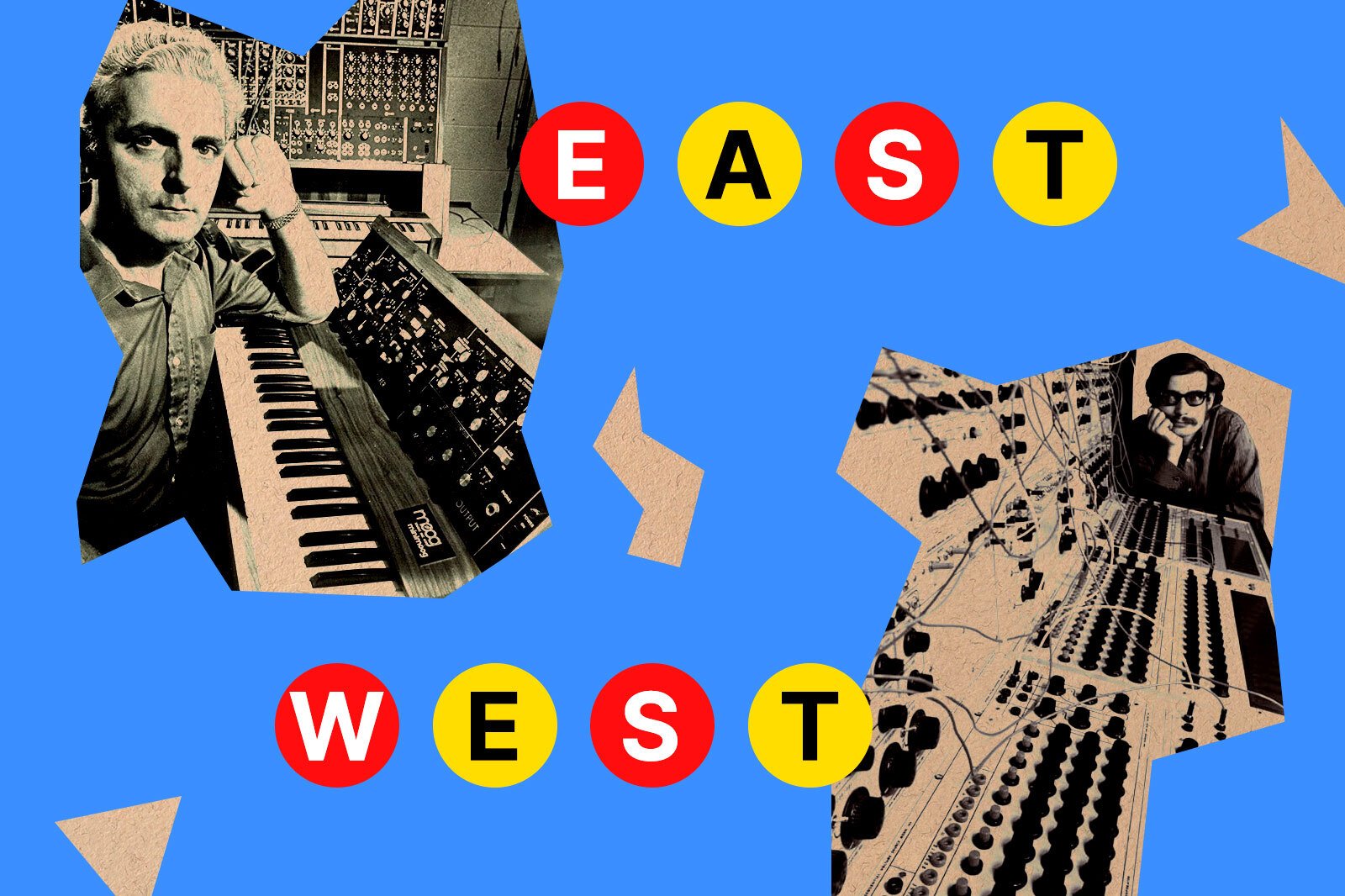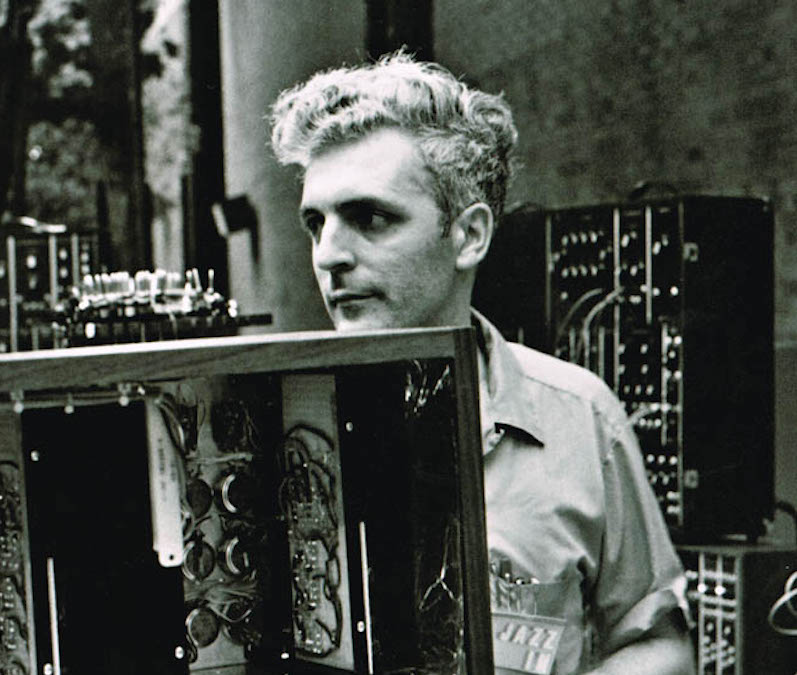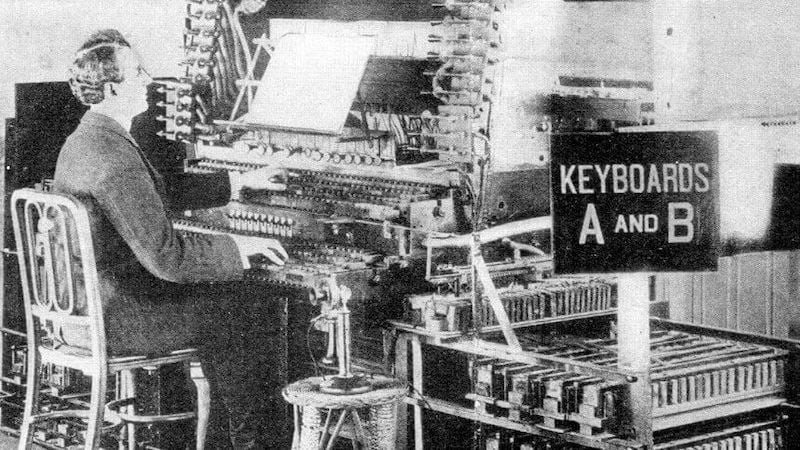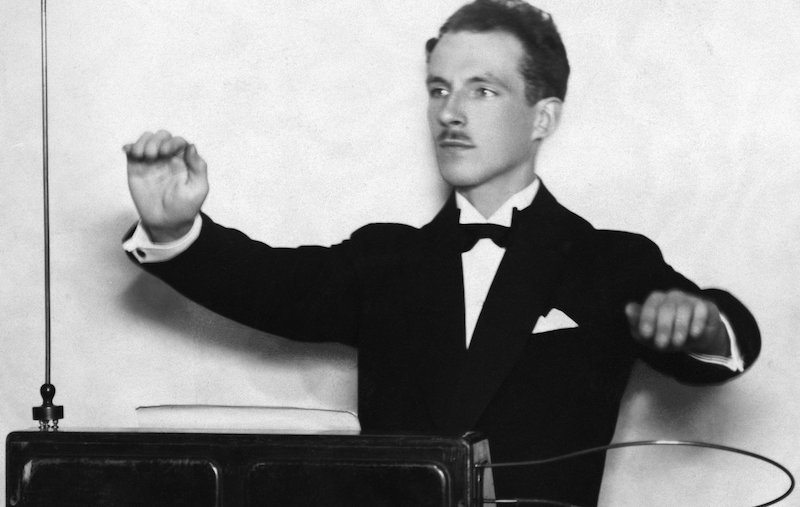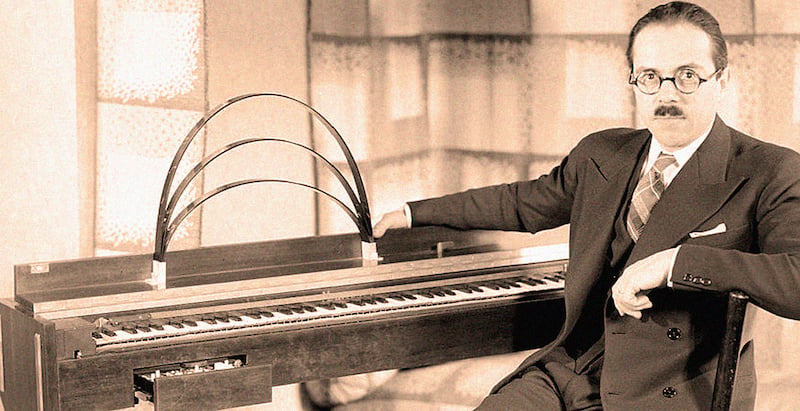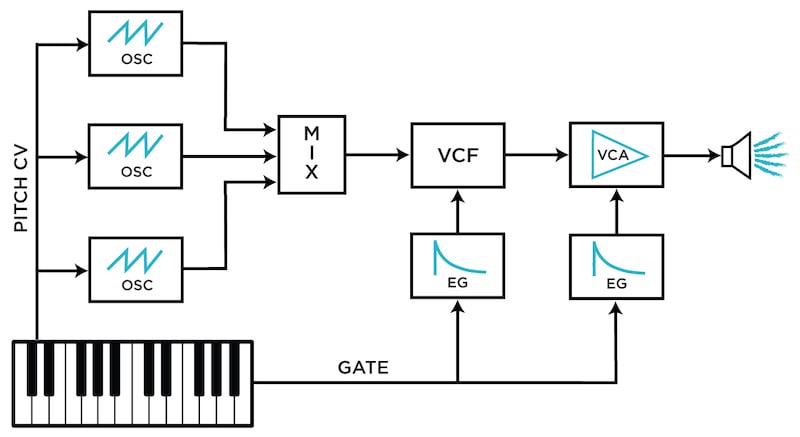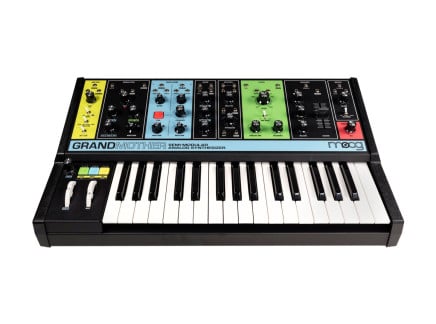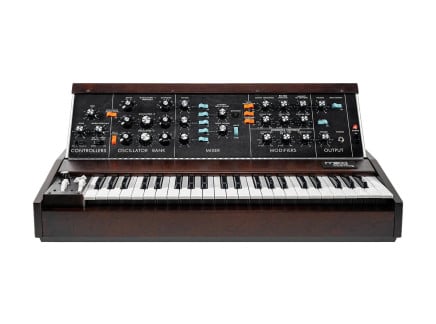In the past several years, the world of synthesis has fostered an ever-intensifying conversation about two fundamentally different approaches to synthesis and electronic instrument design: East Coast synthesis and West Coast synthesis. Emergent narratives strongly characterize these approaches as being in near-complete opposition (or even in competition) with one another—but are they really? And after all, what do these distinctions even mean, anyway?
When writing this article, I originally endeavored to explore this idea by attempting to narrow in on a definition of West Coast synthesis, specifically...which, now that I have written it, I realize required some more storytelling than I had initially anticipated. As such, this article has been broken into two parts—in the first, we'll talk about the origins of electronic music, the birth of the modular synthesizer altogether, the story of Bob Moog and Don Buchla's earliest instruments, and some myths that have accumulated around their inception. In the follow-up article, I'll hone in more specifically on West Coast synthesis, taking a closer look at some of Buchla's later instruments. In that article, we'll also toss some ideas around about what may have caused the "East Coast Synthesis vs. West Coast Synthesis" narrative/myth to continue, and of course, we'll discuss a number of truly fascinating musical ideas as we go. So, before taking a significant detour, let's first get straight to the point: what is West Coast synthesis? And for that matter, what is East Coast synthesis?
West Coast and East Coast Synthesis Defined
Let's start with simple (and essentially true?) popular definitions. What is West Coast synthesis? West Coast synthesis is an approach to musical synthesis and electronic musical instrument design developed by Don Buchla starting in the 1960s. West Coast synthesis favors experimental approaches to music-making, often bringing into question the nature of a composer/performer's interaction with their instrument, as well as the "rules" by which music is organized. (Don Buchla is pictured in the carousel below—image via Buchla USA.)
Many say that West Coast synthesis hinges on the use of complex oscillators, wavefolding, lowpass gates, and dynamic depth FM—and while this is true to an extent, I'd argue that focusing on these concepts ignores a more complex, interesting, and musically compelling layer to the Buchla mystique...one which I hope, by the end of these articles, we'll both better understand.
"West Coast synthesis" as a term requires the concept of "East Coast synthesis" in order to gain full meaning. So, what is East Coast Synthesis? In short, East Coast synthesis is the approach to synthesis and synthesizer design that, in the decades following the 1960s, ultimately gained greater prevalence than the West Coast approach, though that tide is now slowly turning. According to most, East Coast synthesis was developed in the 1960s by Bob Moog (second image in the above carousel, via the Bob Moog Foundation) and associates, privileging the creation of more traditional music and codifying what we now consider the relatively "standard" method of subtractive synthesis: a synthesis method that generates much of its sonic interest by using characterful filters to alter the structure of harmonically-rich oscillators with relatively static timbres. This is the model that, to this day, most commercially-available electronic instruments have followed.
Commonly, these definitions bring along with them an onslaught of anecdotal information that ranges from true to downright false, with plenty of mushy gray area somewhere in between. In so many words, this is largely because of the proliferation of information on the Internet through unchecked sources. Before proceeding, I'd like to express that this topic is something that I'm deeply fascinated by and that I care a lot about. As such, I'll do my best going forward distinguish when something I'm describing is true, when what I'm describing is an inference, when what I'm describing is reasonably reliable secondhand information, and when something I'm describing is not true altogether.
I'll also state clearly before I continue that I'm skeptical about the use of these terms altogether, and I'm unsure that their current definitions are terribly helpful in understanding some of the more interesting nuances of how these instruments work, and how they fit into the larger picture of music history—but it makes for an interesting story, nonetheless. As such, I'm hoping that deeper conversation about them can nudge their popular definitions toward more nuanced territory. So, with these basic conditions out of the way, let's get to the heart of things...how did this all start?
Thwarting Tradition: the Origins of Electronic Music
I've discussed the origins of modular synthesizers in recent article What is a Modular Synthesizer?, as well as an overview article about the new Tiptop Audio + Buchla 200 Series Eurorack Modules. I'd strongly recommend checking those out for additional perspectives on the topic. That said, I'll re-tread some ground here in order to make the full story a bit clearer.
Electronic music has been around for a long time in various forms—in fact, we have had electrically-fueled and fully electronic instruments for well over 100 years now. Popularly-discussed instruments from the earliest days of electronic music-making include the Telharmonium, the theremin, and the ondes Martenot (all pictured below, in that order). These were all splendid devices with their own unique place in the history of instrument design. However, these instruments, despite their charming timbres, found their place making essentially traditional music: music that respected traditional roles of harmony, melody, and rhythm.
For many composers in the early 20th century, however, the growing potential of electricity and electronic devices in the process of music-making promised something more extreme. One popular example of this futuristic mindset comes from composer/theorist Ferruccio Busoni and several of his students/associates (Percy Grainger, Edgard Varèse, and Luigi Russolo among them), who envisioned a world where the influence of machines could change the process and sound of music-making altogether. In their minds, electricity and machines had the potential to forge a musical landscape in which sound could be freed of the oppressive traditions that preceded them. And in fact, Busoni's students and many in their generation lived to see this world come into existence. (See Busoni's Sketch of a New Aesthetic of Music, a treatise about this very topic.)
In some senses, the field of electronic music realized this purpose not with the invention of early instruments like the theremin and ondes Martenot, but with the proliferation of recording media technologies—most dramatically so with the invention of magnetic tape recorders. Aside from its practical purpose, magnetic tape also presented curious artists a way to treat sound like a physical material rather than something ephemeral. Music performance was bound entirely to the passage of time, but recordings captured sound onto easily-manipulated physical media—making it possible to analyze, recreate, reiterate, and gradually transform sounds into something new in the way a sculptor gradually turns rock or clay into something new. Once a sound was recorded, it could be played back at a different speed, reversed, physically chopped into pieces and taped back together in a new order, re-recorded, and so on. These types of processes made it such that, for the first time, sound itself could be meticulously molded, like sonic clay or paint.
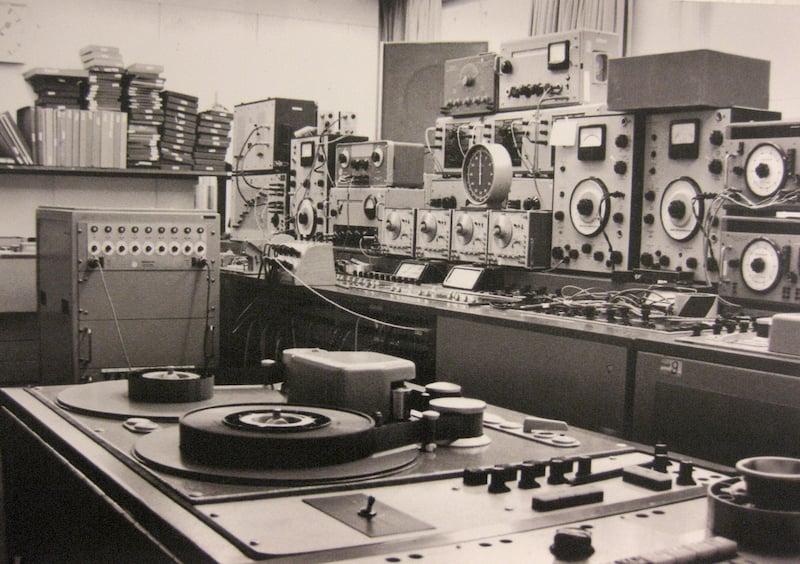
This presented composers with perhaps the first realization of Busoni's dream: a world in which electronics provided an entirely new set of rules by which to use sound to create art. Melody, harmony, and rhythm were no longer the only ways to think about sound, and traditional musical instruments weren't even required. As such, in the 1940s, 1950s, and onward, countless composers made countless amazing pieces of music by thoughtfully recording, manipulating, and editing everyday sounds into elaborate tapestries of mysterious, compelling, and uncanny soundscapes. Many of them worked in radio stations or academic institutions, mis-using scientific test equipment to create and manipulate sound.
There was a catch, of course: editing tape is tedious. At the time, it was one of the best options for making more elaborate sound-based music; true, some composers were fortunate to be able to experiment with early computer-assisted processes, and some composer/engineers were beginning to experiment with creating one-off devices for live performance...but for most musicians, tape was the only practical way to engage in this weird new world of soundmaking. The lack of immediacy, though, was a turn-off for many: spending hours in the studio plotting out a compositional process, tuning test tone generators, and spooling tape machines was a far cry from the immediacy of playing an instrument. As such, in the 1960s, the up-and-coming generation of young composers were collectively beginning to imagine an alternative.
The Origins of the Modular Synthesizer
There were many one-off (or limited production) electronic devices for making electronic sound and music during this time—but most musicians were still working in relative isolation, pooling their collections of tape recorders and test equipment in small communities or around radio stations or academic institutions. We're going to hone in on the early–mid 1960s: the point at which, despite similar devices existing previously, many commonly agree that the synthesizer as we now know it was born.
The birth of the synthesizer is curious, and frankly, it's not possible (or necessary) to pin down precisely who invented it and when (read our article Who Invented the Synthesizer? for more perspective on this). However, we're approaching a part of the history of electronic instrument design where a couple of particularly interesting stories emerge: the stories surrounding Bob Moog and Don Buchla.
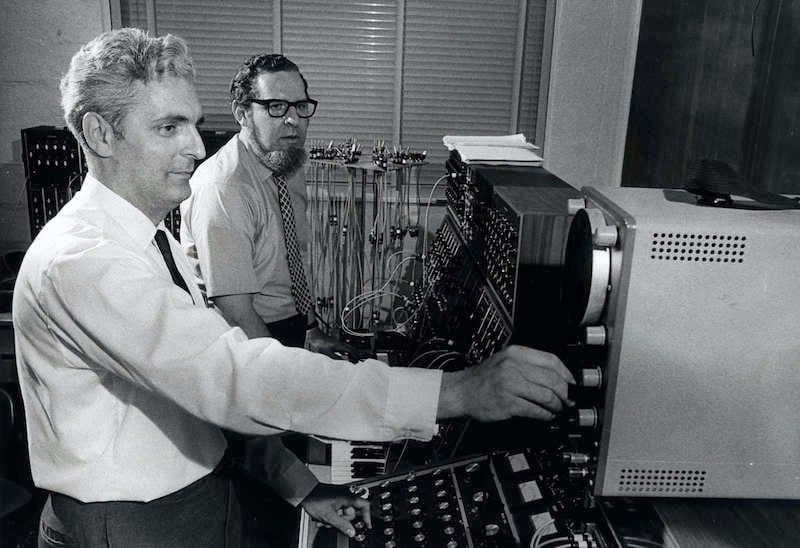
In 1963 in New York (on the East Coast of the United States), inventor/engineer Bob Moog met composer Herb Deutsch at an All State conference (an event organized around a concert of the top music students from the state organized into a single ensemble). Deutsch was there as an educator, and Moog was there among a number of musical instrument vendors, attempting to sell theremins. Deutsch, having recently built a Moog theremin kit, was thrilled to meet Bob: and the two struck a conversation about the potential of electronic music, and the potential of electronic musical instruments. The two formed a friendship, and gradually went to work imagining and building their first general-purpose tool for making electronic music. (Moog and Deutsch are pictured above—image via Moog Music, Inc.)
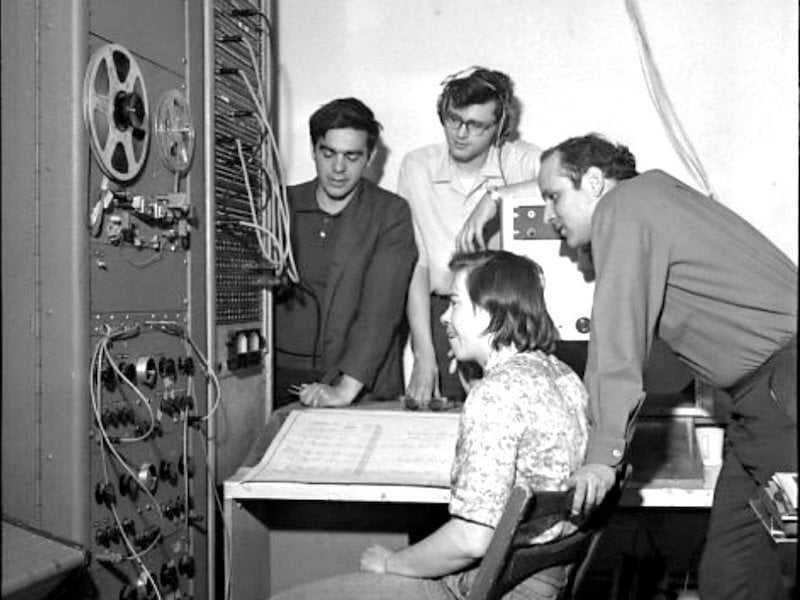 Members of the San Francisco Tape Music Center: Subotnick, Sender, Oliveros, and Mike Callahan
Members of the San Francisco Tape Music Center: Subotnick, Sender, Oliveros, and Mike Callahan
At roughly the same time in San Francisco (on the West Coast of the United States), composer Morton Subotnick (and his San Francisco Tape Music Center colleagues, including Ramon Sender, Bill McGinnis, Pauline Oliveros, and others) were seeking new methodologies of working with tape and electronic sound. Many of their works shied away from extensive tedious tape editing in favor of long-form recordings of peculiar sound sources; this yielded some fascinating music, but it lacked the intricacy of more meticulous tape music works. Eventually, the San Francisco Tape Music Center issued an ad in local papers seeking an engineer to help them build "an electronic music easel," an electronic device which would allow them to create and shape electronic sound in real time, the way a painter works with an easel. Eventually, Don Buchla arrived at their doorstep: and while he purportedly was aiming to use their facilities for music-making, Subotnick presumed he was there in response to the ad. As fate would have it, Buchla was an engineer who shared Subotnick's vision of a weirder musical world. As such, they too set to work on a device that would make this possible.
By c. 1965, each team had at very least a working prototype completed. What is particularly peculiar about all of this is that ultimately, each group's approach to solving the problem of immediacy in electronic music creation was...actually surprisingly similar, despite their allegedly not being aware of one another at all. So, in broad strokes, what did their instruments have in common?
Both Moog and Buchla's early instruments took clear influence from the structure of the typical tape music studio. They contained devices like oscillators, equalizer-like filter banks, mixers, etc. However, rather than the classical tape studio's hodgepodge collection of appropriated scientific test equipment, Moog and Buchla established some standards about the dimensions, connection types, and power supply requirements of their individual devices. In fact, the individual devices were modules designed to be installed into a single cabinet/housing and connected to the same power supply. The individual modules could be interconnected to one another with patch cables, allowing the composer to create any number of different types of sounds by nature of the modules utilized in any given patch and how they were interconnected. This concept was basically the same as how things worked in a tape music studio, but had the added niceties of compactness and direct compatibility between all devices.
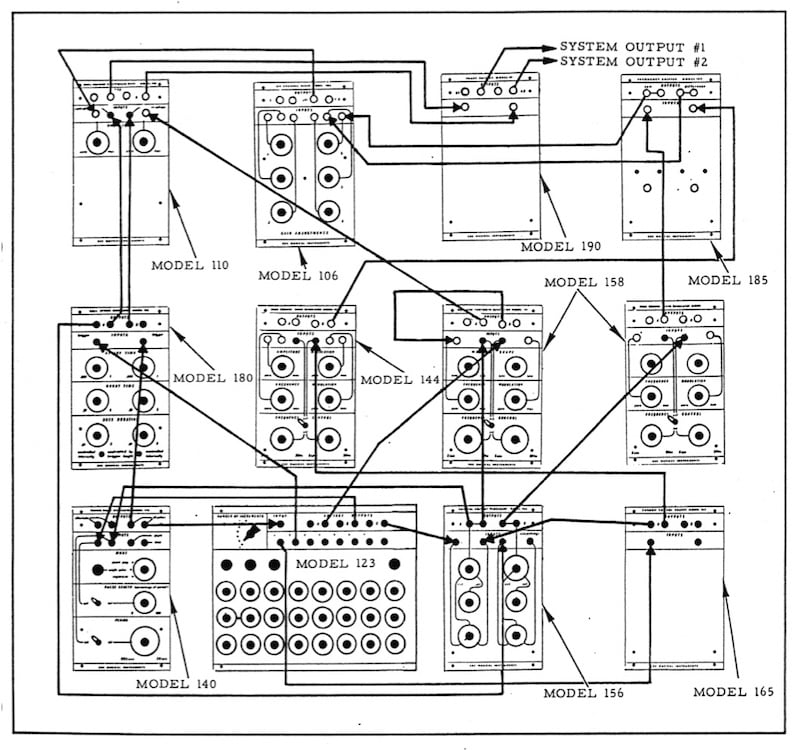 A patch chart for a Buchla 100 system, detailing audio and control voltage patch connections
A patch chart for a Buchla 100 system, detailing audio and control voltage patch connections
The other striking similarity between their instruments, though, was their reliance on control voltage. In each of their systems, modules could be divided into a few different categories: modules that produced sound, modules that modified a sound's characteristics, and modules design to influence the behavior of other modules over time. This last bit—the potential for inter-module influence—was perhaps the most significant breakthrough: it allowed for composers to patch-program transformations in the sound, a process that previously would've required tricky tape editing or, frankly, wouldn't have been possible altogether. At last, composers on each coast were able to make electronic music with an unprecedented degree of efficiency, tightening the relationship between musician and their tools, and allowing for considerably more spontaneous, reactive decision making. This is an idea I think about a lot, and frankly, this newly-possible near-immediate feedback loop between composer and their sonic results was a big deal in shaping the future of music altogether.
So, fundamentally, Moog and Buchla's instruments had a lot in common. But now that we have all of this background established, it's time to get to the main point—what was different about their instruments? Generally speaking, Moog's instruments are sometimes characterized as being designed for (or at least, commonly used for) creating traditional music, whereas Buchla's instruments lean more deeply into experimental means of sound generation and interaction. Why these broad characterizations have come about is a bit difficult to pin down...but let's try.
Moog's Increasing Popularity
We now reach a point in the story where anecdote plays a larger role. Some ideas that follow are objectively true, and some are a matter of perspective—I'll try to point out a few places where considering this will prove particularly interesting, but keep that in mind going forward.
Keep in mind that Moog and Buchla each acted in collaboration with others—however, Moog himself often expressed that he wasn't really a musician, and deferred to his colleagues for many musical decisions. Buchla, on the other hand, did consider himself a musician...and as such, it is reasonable to assume that many of his design decisions were influenced by both his colleagues' and his own musical needs. This...will be important later.

Moog's instruments, after some back and forth among colleagues, added a mechanical black-and-white keyboard (as with the Model 12, pictured above). Of course, the keyboard was just a control voltage source like any other—while it could control the pitch of the instrument's oscillators, it could equally well control any other parameter of the sound (loudness, brightness, etc). However, for musicians unfamiliar with the inner workings of the synthesizer (i.e., basically every musician who encountered the synthesizer), the use of a keyboard for anything other than pitch wasn't exactly a first creative impulse. Instead, many used it similarly to how they would otherwise use a keyboard (though of course, they would learn quickly that they keyboard was not fully polyphonic in the manner of a piano or organ). Now, a funny thing is, Moog's instruments didn't exclusively offer keyboards as controllers; the Moog system had a ribbon controller, for instance, which allowed for continuous changes in voltage. The Moog also had envelope followers, allowing control from external audio sources (as in the music of Annette Peacock). But few musicians seemed to latch onto the more experimental aspects of the Moog system, instead mostly focusing on control via the keyboard.
 The cover for Wendy Carlos's chart-topping Switched-On Bach
The cover for Wendy Carlos's chart-topping Switched-On Bach
In some ways, this was to Moog's benefit. Quite quickly, the instrument was on the radar of creative keyboardists and composers like Keith Emerson and Wendy Carlos, who quickly went on to show the world through example that the synthesizer was a serious instrument capable of a wide range of sounds—from new, alien sweeps and sound effects all the way to elaborate multi-tracked renditions of Bach or rock band arrangements of Aaron Copland. Through this influence, and through the use of the Moog in studio recordings by several adventurous rock albums and film scores, the popular understanding of what a synthesizer was and what a synthesizer was good for came to be something other than what was fundamentally true about the instrument. There was no reason a synthesizer needed to make tonal, rhythmic music, and there was no reason it needed to have a keyboard. But through a combination of luck and partly-accidentally/partly-intentionally building a synthesizer "marketplace" around their instrument's strengths, Moog (the company), their sales force, and musicians at large steered the synthesizer concept away from its avant-garde origins into a position of adding new sounds to otherwise the same sort of music people had been making for decades or centuries before.
For most of the world, this was an exciting revelation, and the face of popular music as a whole changed dramatically in the ensuing decades. But for experimental musicians bent on embracing the idea that technology could lead us toward an entirely new form of music-making, this was a disappointment. The Moog, an instrument with the potential to break free of musical tradition, was becoming yet another tool for making outdated, conventional music.
The Spread of East Coast Synthesis
Is that true? Well, perhaps in part. People made plenty of weird, out-there music with Moog synthesizers. But for the sake of this conversation, it's perhaps more important to focus on this aspect of things: whether or not Moog instruments nudged people toward making conventional music notwithstanding, what we can say is fairly true is that Moog's instruments were hugely influential on the quickly-developing world of synthesizer design.
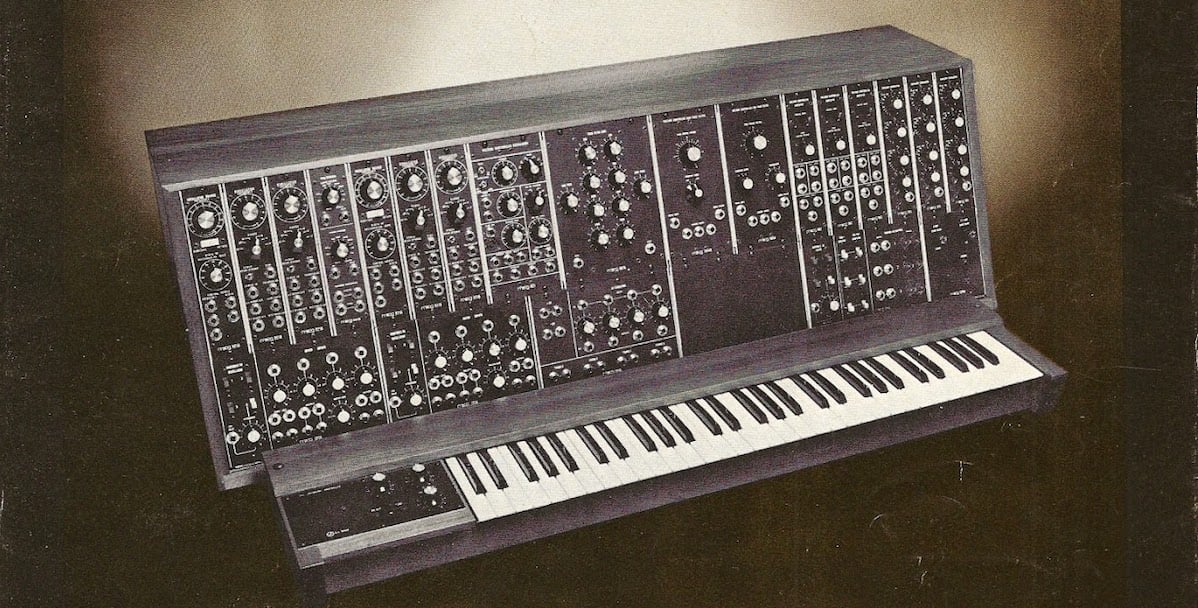
Because of their near-overnight success, Moog instruments became a source of inspiration for eager engineers who sought to enter the newly-emerging electronic instrument marketplace...a marketplace formed largely surrounding needs/ideas influenced by Moog's example of what a synthesizer should be able to do. As such, subsequent developers' instruments were actually fairly similar to Moog's in many ways, often implementing some perceived improvement to any number of aspects of the instrument's functionality. Fairly quickly, a cluster of instrument designers further solidified the popular industry understanding of what a synthesizer was and should be able to do simply by attempting to meet consumer demands while more or less following the Moog "mold" (and no doubt influencing one another along the way). Of course, our concept of what a synthesizer is for has changed a bit over time...but surprisingly, a lot has stayed the same, even up to the current day.
Today, this is what people are generally referring to when they describe "East Coast" synthesis: the ubiquitous commonalities across the synthesizer industry that take clear influence from Moog's early designs. So, that said, what are the characteristics of this design? Let's take a quick look.
Synthesizers following the Moog lineage usually are built around the concept of subtractive synthesis, in which sounds originate from harmonically-rich, stable oscillators with a relatively stable, identifiable pitch—often saw, triangle, or square waves. Several of these oscillators (and perhaps a noise source) are commonly mixed together, and then passed into a characterful filter or set of filters which sculpt the sound by removing harmonic content (lowpass, highpass, bandpass, or filter banks were all possibilities in early Moog systems...check out this article about Moog filters to learn more). Usually, the sound then passes into an amplifier, which allows you to control the loudness of the resulting sound. The filter and amplifier are usually controlled by ADSR envelope generators in order to create user-shapeable articulations for each note. Notes are usually generated by a keyboard, or perhaps by a sequencer, usually sending the same pitch control information to each oscillator. Low-frequency oscillators (LFOs) may be used to apply vibrato, pulse width modulation, filter modulation, tremolo, or other effects. Generally speaking, one of the strongest sonic points of interest is the filter itself; carefully controlling the qualities of the sounds sent to the filter, the filter's settings themselves, and the way they evolve over time are a significant part of achieving variety in this workflow.
Eventually, rather than taking the possibilities offered by modular designs a step further, designers at Moog and other companies instead turned their focus toward developing ever-more compact, immediate, approachable, and affordable instruments. Because this "standard patch" was so ubiquitous that it could almost be assumed, new instruments didn't necessarily need to be modular. Quickly, Moog and others developed self-contained, non-patchable monophonic instruments (such as the Minimoog) which exploited this fundamental synthesis structure; eventually, this framework was also used to create polyphonic keyboard synthesizers. Even today, that remains the prototypical idea of what a synthesizer is altogether, and the Moog influence can be seen in nearly every instrument out there.
Can You Make Experimental Music on a Moog?
Returning to an idea mentioned above: no one ever forced musicians to use a Moog modular synthesizer in this way. Early Moog systems were modular, and as such, you could create any number of types of signal paths—and many performers did use it to quite experimental effect. The filters could self-oscillate and act as sound sources; you could use sample & holds to generate random, evolving sequences; you could cross-modulate oscillators using FM to create rich, chaotic sounds that didn't conform to the conventional ideas of "notes" or "rhythm."
But, speaking anecdotally as a person who has spent time with old Moog modular systems...it's actually sort of difficult to get a Moog system to sound as excellent as it can sound when using it in these ways. Now, I don't have an exhaustive list of quirks that nudge the Moog system toward its "sound" and typical uses, but I do have a couple of personal thoughts based on my own experience with these instruments. Keep in mind, this reflects my personal opinions, based on my experience with only a handful of specific vintage Moog systems. Being that many systems are quite different from one another, the impact of the things I'm about to discuss will vary considerably from instrument to instrument and player to player—but I do think that they're worth considering, nonetheless.
From my perspective, one noteworthy oddity is that the voltage output ranges of 901B oscillators are fairly low, so they don't yield very dramatic results as FM sources or as modulators for other parameters; the 901B required the rare 901C module to amplify output levels for use as a modulator. Compared to the 901B, the later 901 oscillator can produce a higher output voltage range...but needing to remember that is a step in the way of deeper experimentation, especially when you are first learning the instrument's workflow and forming your own patching habits. For that matter, many compact Moog modular systems didn't even have a 901C or multiple 901s...so many patches hypothetically possible with super deep audio-rate modulation were out of reach for many. The same remained true for later systems which incorporated the 921B and 921 oscillators in place of the 901B and 901.
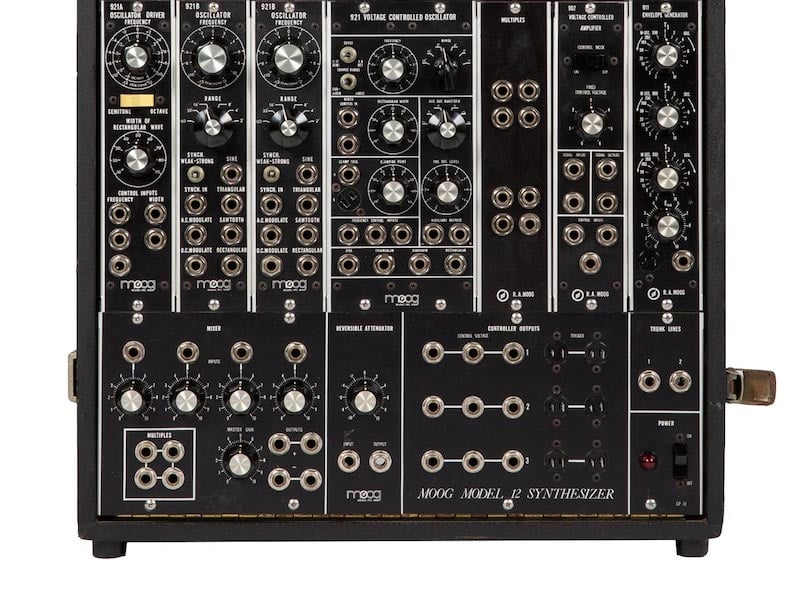 Note the Cinch terminal S-trig connectors on the Controller Output section and Envelope inputs
Note the Cinch terminal S-trig connectors on the Controller Output section and Envelope inputs
Another peculiarity is the Moog system's use of multiple types of "event initiation" signal, each with their own types of connectors: S-trigger (which used Cinch blade connectors) and V-trigger (which used standard 1/4" TS cables). Unlike modern Eurorack systems, which use "gates" and "triggers" as event initiation signals, Moog systems perplexingly used completely different standards for triggering to/from different modules. S-trig connections were used to connect keyboards or other external controllers to envelopes (and select other modules); V-trigs (like modern Eurorack gates) were used to advance sequencers, select sequencer stages, etc. Some modules featured both S-trig and V-trig functionality (like the 928 Sample & Hold), while others simply stuck with one format or the other. The 961 Interface module could be used to convert S-trig to V-trig and vice versa...but not every system had one...and as such, in many models of purchase-ready Moog system, it simply wasn't even possible to trigger an envelope, for instance, from anything other than a keyboard. Even in systems that did have the ability to cross-patch these event initiation signals, an extra step of thought had to go into crossing these streams, ever-so-slightly complicating the process of experimentation.
And if I can offer some more anecdotal thoughts...in my honest personal opinion, the Moog system just doesn't sound at its best when wrenching it into cross-modulation patches or evolving generative experimental soundscapes. The instrument's soul really hinges on how dang nice the filters sound, and frankly, without those filters, I'm not entirely sure how special the instrument would feel. In my own use of Moog systems, I always wind up finding that it doesn't feel worth the trouble to get super deep into gnarly FM or feedback or other "extended techniques": instead, it always winds up feeling way more gratifying to just make the filter the center of attention, following right along with the "subtractive synthesis" playbook (a playbook that—remember—was developed following the Moog's strengths). Your mileage, of course, may vary.
So in summary, you could absolutely use a Moog modular system to do experimental synthesis tricks...but again, in many configurations, the instrument really leaned users toward playing the instrument with a keyboard. And of course, much can be said about context—once musicians heard more and more examples of how synthesizers were being used in popular music, the "blank slate" of the synthesizer gradually disappeared. As discussed above, this in part solidified what would eventually be known as the more-or-less standard "East Coast" instrument design: multiple oscillators into a mixer into a filter into a VCA with a couple of envelopes and an LFO, all controlled by a keyboard.
The Buchla Myth
Well, now that I've gone through what might seem like a ridiculously long tangent talking about East Coast synthesis in an article I originally thought was about West Coast synthesis, let's...get back on course. Here's the deal: the Moog synthesizer archetype is super familiar to most electronic musicians, such that for many, it really does seem like the default way that a synthesizer should work, despite the fact that not too long ago, in the early 1960s, none of this stuff even existed. Keep that in mind.
These days, because of the sheer ubiquity of Moog-like designs, common explanations of Buchla's approach often hinge around pinning down, intensifying, and overstating differences between his instruments and Moog's, often to the point of simply not being true. Now, the thing is, I do believe that there are fundamental differences in their approaches that are worth considering, but frankly, I think that many of the points that often come up are fairly reductive, unhelpful, or even downright false. At this point, I am going to call out a few such overstated myths, after which, I'll move on toward describing what Buchla's instruments actually were like. Ultimately, in the ensuing follow-up article, we'll take a closer look at why, while helpful in some ways, the West Coast/East Coast distinction is...also weirdly reductive and perhaps misses some of the most interesting points altogether.
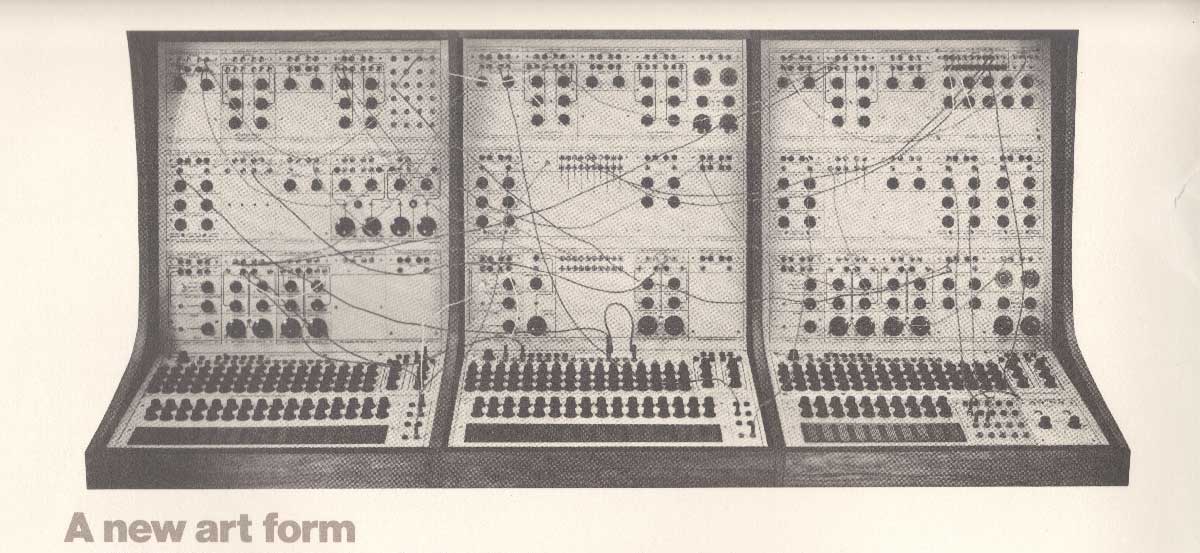
Myth number 1: Buchla's approach is centered around additive synthesis. Heck, Don Buchla invented additive synthesis. Myth number 2: Buchla hated black-and-white keyboards. His instruments didn't use them. Myth number 3: Buchla's instruments didn't use filters.
I feel like every time I hear some new definition of West Coast synthesis, more and more myths pile on. But now that we've looked at the influence of Moog instruments, and now that we've talked about some stuff that isn't true about Buchla instruments...let's talk about what is true about Buchla instruments.
West Coast Origins: What's So Different About Buchla and Moog?
As discussed, Moog's instruments, by nature of their design and the early influential music created with them, generally did lean musicians toward making relatively familiar forms of music. Buchla and his associates, however, kept the radical notion of a new form of music in mind in all of their endeavors. A mix of academic experimental musicians and eccentrics from the 1960s Californian countercultural movement, they kept experimentation at their heart, and constantly strove to explore the new, peculiar possibilities that emerging technologies could provide for both music and human-machine interaction.
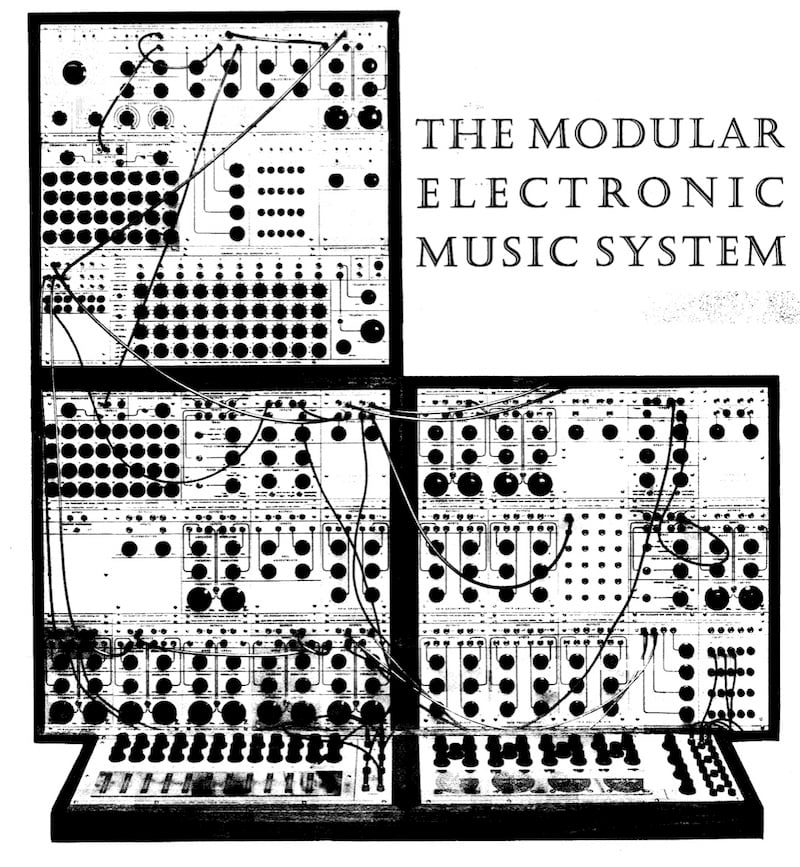
It is true that the earliest Buchla systems (the 100 Series) were conceived in opposition to the idea of a black-and-white keyboard. Subotnick is especially vocal about the exclusion of the keyboard from these instruments, feeling grave concern that a mechanical keyboard may have upended the entire endeavor of making a new form of music. Instead, for tactile control, the Buchla 100 embraced resistive (and eventually capacitive) touch plates for producing control voltages, timing pulses, and even "pressure" CV for expressive performance opportunities. As we'll see going forward, experimental approaches to interaction were always key in Buchla's inventions.
It is also true that the generally interesting parts about sound production in the Buchla 100 System didn't center around filters (of which the system only had two, the 191 Sharp Cutoff Filter and 192 Dual Lopass filter...as well as two models of filter bank and a vanishingly-rare prototype dual low pass filter). Instead, many of the interesting timbres associated with these systems are generated through audio-rate modulation: the use of one high-frequency sound source to change some aspect of the other, yielding fairly complex sonic results from otherwise ostensibly simple modules. Early Buchla oscillators relied on absurdly deep analog FM to create bizarre, huge sounds with complex overtone structures, and often, a relatively ambiguous sense of pitch. I suspect this is where the "additive" myth comes from—even from the earliest stages, Buchla's instruments created harmonic interest by complicating the overtone structure of oscillators with simple waveshapes, unlike Moog, whose instruments relied more unilaterally on filtering harmonic content out of otherwise harmonically rich sound sources with a relatively stable sense of pitch. Of course, as said, the Buchla did have filters, saw waves, square waves—listen to Subotnick's Silver Apples of the Moon and The Wild Bull if you need further proof. But the filters didn't have the resonance and character of Moog's design, and they were quite rare...so they simply weren't part of every Buchla composition under the sun.
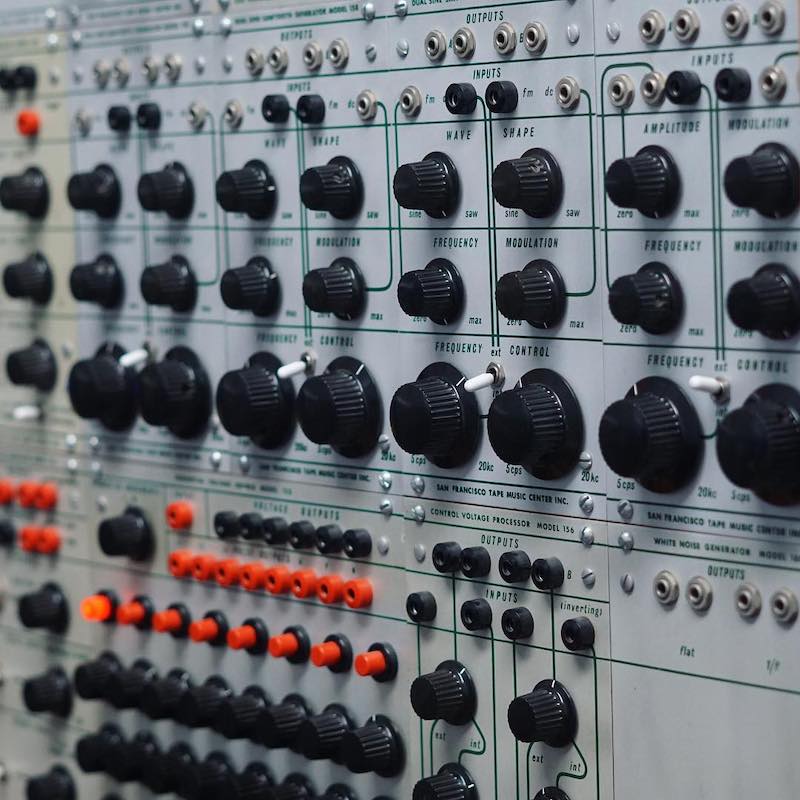 An original Buchla 100 Series system, complete with both Tini-Jax and banana cable connections. Image via Sarah Belle Reid.
An original Buchla 100 Series system, complete with both Tini-Jax and banana cable connections. Image via Sarah Belle Reid.
People also seem to like to point out that Buchla's system had sequencers and random voltage generators available as control sources—this is true, but it was also true of many Moog modular systems. Perhaps this distinction is related to the fact that, generally speaking, Moog seems to have produced many more "compact" systems than Buchla in these early years. As such, many smaller Moog systems excluded these types of control sources altogether, supplanting them with keyboard control, whereas most Buchla systems from the era seem to have been a bit larger, and as such featured a fuller complement of modules. This is pure speculation, but speculation that I'll no doubt continue to ponder and research.
On the more objective end of things, it's also worth noting that Buchla's patch cable scheme was quite different from Moog's. In the Buchla ecosystem, audio signals are carried over Switchcraft 3.58mm Tini-Jax cables; control voltages and timing pulse signals are carried over banana jacks. This separation of audio and control signals for some remains a point of contention—and I promise I'll discuss that in greater depth in my follow-up article about "West Coast synthesis"—but for the moment, I'd like to state the importance of all timing pulse signals using uniform cable type/electrical parameters. This meant that, in Buchla's instrument, it was quite straightforward for any pulse source to interface with any viable pulse destination, and for pulses to be treated as control voltages. It became simple for keyboards to advance sequencers, for clock generators to directly trigger envelopes, for sequencers to trigger envelopes, etc.: and as such, self-perpetuating generative musical structures are quite natural on the Buchla in a way that they aren't on the Moog (per earlier discussion about V-trig vs. S-trig signals). This was a huge deal: a primary way of "playing" the Buchla was to create a patch that, for the most part, played itself. The role of the composer/performer was to establish the instrument's behavior via patching, and then to listen carefully, adjust, listen, adjust, listen, adjust, and so on—a co-creative, interactive, feedback-like process that would become central to how Buchla thought about his own devices. Speaking as a person who has played each instrument a fair bit, this process (to me) feels considerably more seamless on the Buchla than it does on the Moog.
So, the 100 Series was an incredible instrument, full of bizarre sounds. While it certainly contained all the resources you could need to make conventional music—sequencers, tune-able touchplate keyboards, and the like—its lack of a familiar musical interface and its embrace of extremes (be they extreme frequency ranges, extreme modulation depths, extreme speeds) meant that it naturally leaned much farther toward the experimental than did Moog's instrument. It simply wasn't a tool designed to produce "normal" music, and as such, it was in some ways doomed to obscurity in the face of Moog's commercial successes.
The Buchla 100 laid the groundwork for what would come to be called "West Coast synthesis." And in fact, the East/West coast terminology emerged quite early on, specifically to distinguish between Moog and Buchla's organizational schemes and approaches to soundmaking. The thing is...despite that fact, and despite the fact that some of the most iconic music made with Buchla instruments was produced with 100 Series instruments, when people describe the "Buchla sound" or "West Coast synthesis" in the present day, they're usually talking about Buchla's next instrument: the 200 Series.
But What is West Coast Synthesis, Really? To be Continued...
Cue the dramatic music! In the follow-up to this article, we'll dive deeper into the story of West Coast synthesis specifically. We'll discuss the Buchla 200 Series, which brought us many of the modules considered today to be foundational to "the Buchla sound." We'll also discuss developments in Buchla's instrument design from the 1970s onward, attempting to track how some patently Buchla-esque ideas evolved across the decades.
With the lens of hindsight firmly at our advantage, we'll then take a closer look at the terms "East Coast" and "West Coast" altogether. We'll postulate where they came from, discuss some historical uses, and at the end of the day, discuss why these terms are perhaps more limiting than they are helpful, both from an historical and musical perspective. So keep your eyes peeled—hopefully we'll be able to definitively answer the question: "What is West Coast Synthesis...Really?"

